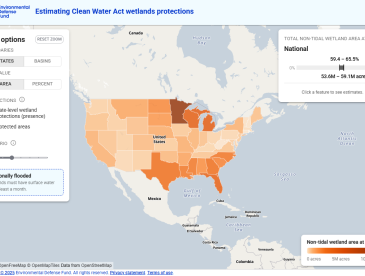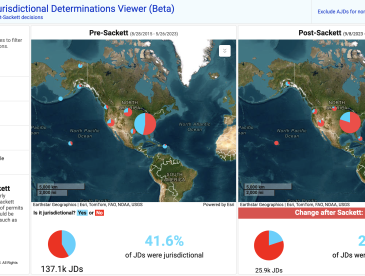We’re advocating for wetland protections — because wetlands protect us
Wetlands are some of Earth’s most vital ecosystems, but they are at serious risk. Wetlands clean our water, provide critical habitat, support recreational industries and are pivotal in protecting communities from flooding, the costliest natural hazard in the United States.
Wetland loss due to development and ongoing rollbacks in protections are putting more communities and ecosystems at risk.
What we are doing to save wetlands

EDF is working together with scientists, advocates and policymakers to better quantify, communicate and protect wetlands and the benefits they provide. Through cutting-edge science, economics and policy development, as well as partnerships across a wide spectrum of stakeholders, we are creating more public understanding of the benefits that wetlands provide.
Take a closer look
The U.S. government once recognized that wetlands connected to federal waterways, including those connected below the surface, should be protected under the Clean Water Act. But in 2023, a majority opinion by the Supreme Court drastically scaled back those federal protections in an opinion now stating that wetlands must have “a continuous surface connection” to federal waters. This language is not grounded in science and establishes tremendous uncertainty as to how this will be interpreted in the long term.
An analysis from EDF, peer-reviewed and published in the journal Science, estimates that between 17-90 million acres of wetlands could now be threatened (for reference, California is 100 million acres in size). The Supreme Court’s decision is compounded by the fact that many states have few or no state protections, with 22 states currently relying entirely on the federal wetlands protections determined by the Clean Water Act. In short, this means many of these wetlands may have no protection at all.
To protect wetlands and support the communities that rely on them, EDF is calling on state governments to create or maintain strong wetland safeguards. We also urge the U.S. government to restore federal protections by pursuing the nation’s long-time goal of “no net loss of wetlands” and taking actions to build flood resilience.

Resources
- Interactive tool
How many wetlands are at risk?
- Interactive tool
Track on-the-ground wetlands protections

Staff perspective
EDF is committed to building resilience against increasing climate impacts. There is an urgent need to strengthen federal, state and local wetland protections to protect our communities from flooding, keep our waters clean, safeguard vital habitat and support our economies.
Will McDow
Associate Vice President, Climate Resilient Coasts & Watersheds, EDF
Updates
- Article
Wetlands are worth it: Here’s why we should protect our wetlands
- Blog post
On this International Day for Disaster Risk Reduction, protecting the Nation’s wetlands is more important and urgent than ever
- Blog post
Our Nation’s wetlands are at risk. So is our ability to manage flooding.
- Blog post
One year ago, the U.S. Supreme Court rolled back federal wetland protections. Here are the impacts so far.
- Analysis
How wet must a wetland be to have federal protections in post-Sackett US?
- Fact sheet
Millions of Florida wetlands could be at risk in the wake of a US Supreme Court decision.
- Fact sheet
Virginia’s strong state wetlands protections must be maintained in the wake of a recent US Supreme Court decision.
- Fact sheet
Millions of acres of North Carolina wetlands could be at risk in the wake of a recent US Supreme Court decision.












